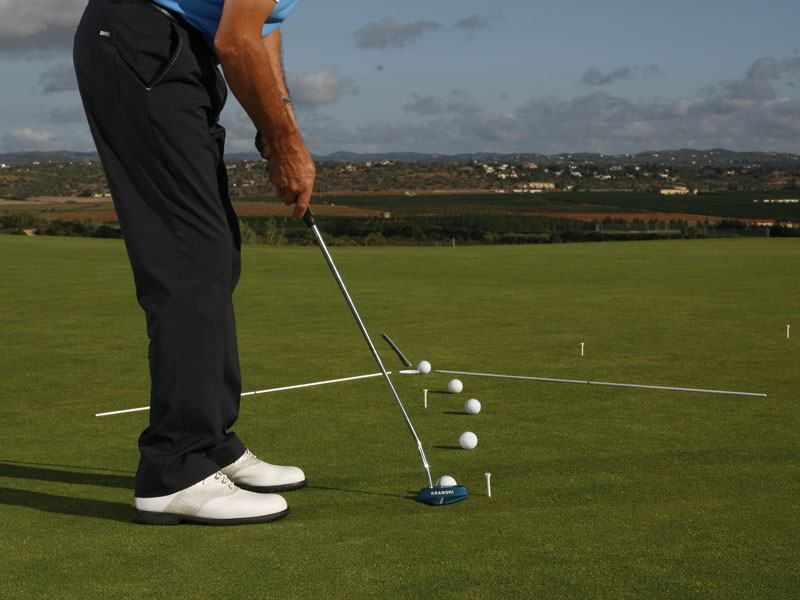Practice putting drills video
Keith Williams has 10 practice putting drills to improve your stroke fundamentals and help you hole more short putts.


Keith Williams has 10 practice putting drills to improve your stroke fundamentals and help you hole more short putts.
Rise angle
You will occasionally hear coaches talk about “rise angle” when referring to putting technique, but what is it?
On the greens, you need to strike the ball on the upswing. This creates topspin, which in turn delivers a stronger roll.
A drill designed to help you groove the correct rise angle is to place a tee in the ground just behind your ball.
If you can strike the ball without touching the tee, you’ll be hitting it on an upward angle. Make sure your left wrist doesn’t break to create the upward hit, and the hands rise on a smooth, upward arc.
Subscribe to the Golf Monthly newsletter to stay up to date with all the latest tour news, equipment news, reviews, head-to-heads and buyer’s guides from our team of experienced experts.
Centre of gravity
The best putters in the world – and I’m sure you will have noticed how Tiger Woods does this – are able to remain incredibly still as they stroke the ball.
This is one of those key elements that is often lost as a player progresses through a pressure-filled competitive season.
To help get you back on track, hit some putts with a wider stance. This will lower your centre of gravity, shallow out the angle of the stroke and improve the quality of your strikes. It’s a great drill to fall back on from time to time.
Read and line check
Start by drawing a line on your ball. Then, having read the putt, aim the line on your ball on the ideal starting point.
Use an alignment stick or shaft to ensure it is spot on. Once you’re sure this is in exactly the right position, address the ball.
As you stand over it, that line should still appear to be aiming at exactly the right spot. If it isn’t, then it’s time to check your head/eye position, as it might be too far inside or outside the ball.
Use this method to make a quick adjustment and you’ll be able to see exactly the right line at address.
Stability drill
One of the main reasons golfers struggle with their putting is that their wrists become too active during the stroke, flicking the club at the ball.
This will destroy the consistency of the stroke and kill your distance control. In practice, take your right hand off the putter and move your left down the grip so the top of the club sits against the inside of your left arm.
Hit a series of putts keeping the top of the shaft against your left arm. This should give you a real feel for how solid the stroke can be.
Rhythm drill
A steady acceleration is essential for a solid, consistent stroke. A good way of remembering this is that it should take two or three times longer to reach the top of your backswing as it does to go from there to impact.
To help you with this, practise the following drill. As you hit a putt, say to yourself “one, two” to the top of the backswing, and “one” from the top to impact. Alternatively, say “fish and”… “chips”.
Short-range test
One of the big mistakes amateurs make when they practise is to hit the same putt over and over again.
This will do nothing to help you when you’re stood over a nerve-wracking four-footer for par in the club championship.
To prepare for the pressure of short putts, place six tees around a hole – three at three feet, and three at six feet.
Now work your way around the circle, each three-foot putt followed by a six-footer. This will do a great job of ingraining your routine, while also improving your focus over those tricky short putts. Remember to take note of your score.
Pace and line
This drill is great for honing your feel for pace when you’re facing a putt with a reasonable amount of break.
I’ve set up three stations around the hole on a slight slope, using three alignment sticks so that each putt is made from a different zone.
For each putt, I’ve also placed a tee peg halfway to the hole. Hitting two balls from each station, you’ll need both pace and line to be spot on.
The tee peg will help you pick the right line, and as long as you hit the ball hard enough to get it to the hole without it running into the alignment stick, you should make the putt.
Ladder drill
It’s often said that the hardest putts are the straight ones. This is one of my favourite practice putting drills, and will check whether you’re able to start the ball rolling on the right line consistently.
Find a straight putt and place tee pegs at three, six, nine, 12 and 15 feet from the hole. Hit two balls from each tee, starting with the nearest and moving away from the hole.
Not only will you have to start each putt on line, but you’ll also need to keep the mechanics of your stroke working well as the pressure starts to mount.
Speed test
Good distance control is perhaps the most important element to solid putting. For this test, find a gentle slope, place two tees two feet apart at the bottom of the slope, then walk 15 feet and place another two tees two feet apart at the top of the slope.
Hit five putts up the slope, then five down the slope. How many consecutive putts can you get spot on?
Roll and line test
As our attention inevitably gets drawn towards the hole, we often miss breaking putts on the low side.
This drill has been designed to help you aim correctly and, more importantly, roll your putts on the right line.
Find a putt with a gentle break, then roll a few putts towards the hole to get an idea of the exact line. Now place two tee pegs in the ground, about a clubhead’s width apart, at the apex of the curve.
Now hit three balls from six, eight and ten feet, aiming to get the ball running straight through the gate and into the hole. As you concentrate on the gate and not the hole, your success rate should increase.

Tom Clarke joined Golf Monthly as a sub editor in 2009 being promoted to content editor in 2012 and then senior content editor in 2014, before becoming Sports Digital Editor for the Sport Vertical within Future in 2022. Tom currently looks after all the digital products that Golf Monthly produce including Strategy and Content Planning for the website and social media - Tom also assists the Cycling, Football, Rugby and Marine titles at Future. Tom plays off 16 and lists Augusta National (name drop), Old Head and Le Touessrok as the favourite courses he has played. Tom is an avid viewer of all golf content with a particularly in depth knowledge of the pro tour.